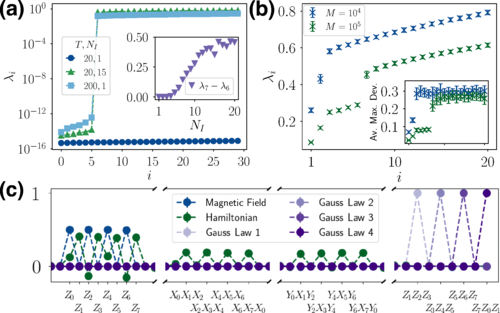Researchers from the California Institute of Technology and Google Quantum AI have developed a learning algorithm that can identify conservation laws in quantum dynamics. The algorithm combines classical shadow formalism and data analysis techniques, allowing it to discover all conservation laws in unknown quantum dynamics with rigorous performance guarantees.
The method can be directly applied in quantum experiments. The team’s work is significant as it can efficiently learn all conserved quantities in quantum dynamics, overcoming constraints of previous methods. The algorithm’s theoretical guarantees include polynomial sample and computational complexities in the system size and precision.
What is the New Learning Algorithm for Discovering Conservation Laws in Quantum Dynamics?
A team of researchers from the Institute for Quantum Information and Matter, the Division of Chemistry and Chemical Engineering, and the Walter Burke Institute for Theoretical Physics at the California Institute of Technology, along with Google Quantum AI, have developed a learning algorithm for discovering conservation laws in quantum dynamics. The algorithm is designed to identify conserved quantities that arise from local and global symmetries in closed and open quantum many-body systems.
The algorithm combines the classical shadow formalism for estimating expectation values of observable and data analysis techniques based on singular value decompositions and robust polynomial interpolation. This allows it to discover all such conservation laws in unknown quantum dynamics with rigorous performance guarantees. The method can be directly realized in quantum experiments, which the team has illustrated with numerical simulations using closed and open quantum system dynamics in a Z2 gauge theory and in many-body localized spin chains.
How Does Machine Learning Play a Role in Physical Sciences?
Machine learning (ML) is playing an increasingly important role in physical sciences. The ability of ML to recognize patterns in data greatly facilitates the data-driven approach to scientific research where scientific discoveries are achieved by analyzing experimental data. Many works have been done to discover physical laws with ML models.
The conservation law or the integral of motion is also an important concept in quantum mechanics. There are usually many global conservation laws in quantum dynamics such as the eigenstate projection operators when the dynamics are governed by a Hamiltonian. However, these do not imply any special dynamical properties. In the quantum setting, the physically relevant conservation laws are those with locality structure.
What is the Significance of Local Integrals of Motion in Quantum Mechanics?
Local integrals of motion underlie the absence of thermalization and transport in certain quantum systems, in contrast to ergodic systems which typically conserve only a few globally supported quantities such as the total energy or number of particles. Thus, local integrals of motion are central for our understanding of phenomena such as many-body localization and Hilbert space fragmentation.
The team’s work considers a broad class of conservation laws with conserved quantities given by sums of geometrically local observables. These conservation laws can be geometrically localized or have support across the entire system. The team proposes an algorithm for discovering all such conservation laws in arbitrary quantum dynamical systems.
How Does the New Algorithm Work?
The algorithm combines classical shadow formalism and several data analysis techniques. The algorithm uses classical shadows to estimate the expectation values of many Pauli observables at multiple times during the quantum dynamics based on a limited number of randomized measurements. After estimating the expectation values, the algorithm performs singular value decomposition (SVD) on a data matrix and gets the low-dimensional manifold corresponding to the conservation laws.
The team rigorously proves that the algorithm can efficiently learn all conserved quantities that are sums of geometrically local observables in quantum dynamics. Although some previous papers are using numerical techniques to find such conservation laws based on known Hamiltonians, the team’s method can be directly applied to experiments to find conservation laws in arbitrary unknown quantum dynamics.
What are the Advantages of the New Algorithm?
The new algorithm comes with theoretical guarantees that the sample and computational complexities are both polynomial in the system size and precision. For Hamiltonian dynamics, one could also obtain conservation laws by first learning the Hamiltonian. However, Hamiltonian learning protocols only work efficiently when there are some known sparsity or locality constraints on the Hamiltonian.
For quantum dynamics without such sparsity structure, prior works involve exponential sample complexity or classical post-processing cost. In comparison, the team’s methods are not subject to these constraints. In addition, they allow for the learning of state-dependent conservation laws and are not restricted to Hamiltonian dynamics. The team performed numerical experiments illustrating the learning of conserved quantities in closed and open systems.
Publication details: “Learning Conservation Laws in Unknown Quantum Dynamics”
Publication Date: 2024-03-22
Authors: Yongtao Zhan, Andreas Elben, Hsin-Yuan Huang, Yu Tong, et al.
Source: PRX Quantum 5, 010350
DOI: https://doi.org/10.1103/PRXQuantu m.5.010350

